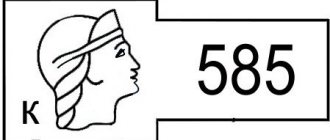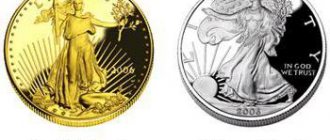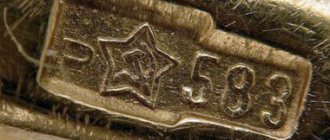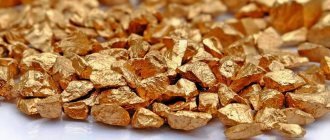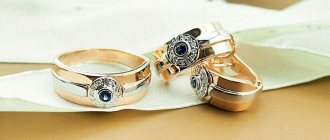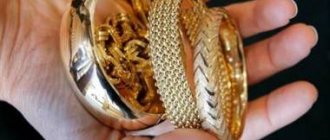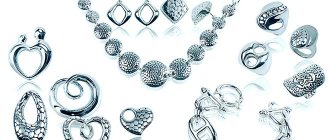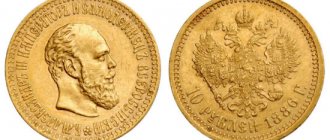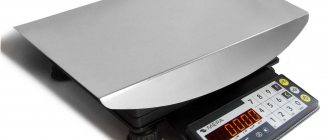What types of gold are there?
In Russia, precious metals presented on store shelves must be labeled. There are only 7 gold hallmarks. At present, some of them are outdated:
- 375. Precious metal content 37.5%. The rest is a ligature (admixture).
- 500. Contains 50% pure gold. It is rare nowadays.
- 583. Precious metal content 58.3%.
- 585. 58.5% precious metal. This includes 80% of jewelry sold.
- 750. Contains at least 75% pure gold. Widely distributed among exclusive jewelry and diamond jewelry.
- 958. 95.8% precious metal. A small number of such jewelry were produced in past centuries.
- 999. Pure gold. The metal is too soft, so it is not used in jewelry.
As you can see, 925 is not among them.
Samples of precious metals
The sample represents a certain standard indicating the ratio of the pure substance and the additional components of the alloy. Each of the precious metals has its own system of such standards, as well as a corresponding type of mark, which an ordinary consumer can see on the finished product.
Gold samples listed in Russia.
In the Russian Federation, the following markings are provided for yellow precious metal: 375, 500, 585, 750, 958 and 999. The 585 marking is considered the most common in use. It is characterized by good resistance to mechanical stress, wear resistance, and an affordable price. The next in order, 750 standard, is already more expensive; it is used for products with filigree, thin drifts and for settings of fragile precious stones. Gold of the highest grades is very soft, polishing on a product made from an alloy with an element content of 95.8% will not last long, so it is not practical to use such metal in the mass production of jewelry.
What other types of gold are there in jewelry? The number 925 is not in the specified list, because it refers to silver markings. For this metal in the Russian Federation there are 800, 830, 875, 925, 960 and 999 standards. According to the requirements of Russian legislation, the mark with the number 925 can only appear on a silver product.
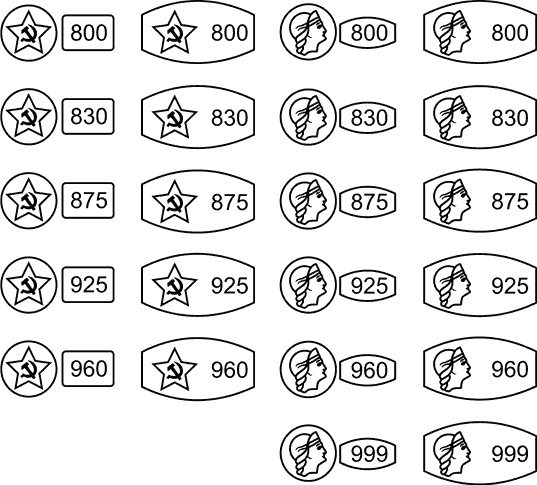
Marking of silver samples.
Theoretically, the existence of 925 yellow metal is possible, that is, it can have the same markings as cheaper silver. But in world standards that apply to jewelry activities, there is no such gold alloy. Gold 925 will be practically no different from the already available options, as well as the pure substance. It will be inconvenient to use it in production due to the technical characteristics that are transferred to the alloy from other components of the alloy.
How to distinguish silver and white gold?
It is difficult to understand with the naked eye how silver differs from white gold. Reading the labels will help. New items - both silver and gold - can be the same color due to the finishing treatment - rhodium plating. Platinum group metal is applied to enhance shine and protect against darkening.
If there are no markings, you can check the quality of the metal at a pawnshop or workshop. The employee will conduct a rapid analysis using:
- Reagents. To check, you will need to file the product a little so that a fresh cut appears, onto which the reagent is applied. There should be no reaction when testing gold. If it passes, it means that the metal does not correspond to the declared standard. When checking silver, the cut area will acquire a reddish-brown tint. If this is not the case, it means that this is a product made from a different alloy.
- Touchstone. Alloys of precious metals are tested using individual rocks. The product is rubbed on the touchstone. If the trace left does not meet established standards, then the alloy contains a lower percentage of pure metal than stated.
- Electronic analyzer. Some stores, workshops or pawn shops have equipment that determines the exact percentage of precious metal content in the alloy. Rarely seen.
At home you can perform the following check:
- Paper. Draw metal along the sheet. Gold jewelry will not leave a mark, silver (even high, 925) should leave a dark stripe behind it.
- Acid. Pour a spoonful of vinegar into a glass of water and stir. After this, place the item being tested into the solution. If you have silver in front of you, the water will change color and become dark. The product itself will oxidize. This will not happen with gold: it is not afraid of an acidic environment.
- Iodine can be used to draw a stripe on an object. There will be no mark left on gold jewelry. If it is silver, the product will become stained and it will be difficult to remove the iodine.
Carat sample system
The multiple hallmark system provides that 1 carat is equal to one twenty-fourth of the weight of the alloy, according to the British carat system. Russia switched to this system in 1927, after which the metric system was introduced. In addition, previously the country used the 583 gold standard, which was slightly inferior to the Western 14K, so it was decided to use the 585 standard.
How to convert carat to metric?
In order to independently navigate both sample systems, widespread throughout the world, you need to know how to convert the value of a metric sample into a carat sample and vice versa.
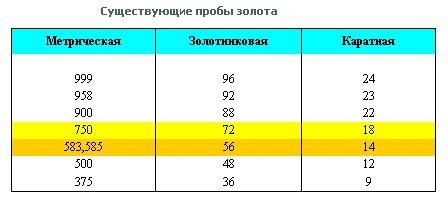
Sample correspondence table.
To do this, it is necessary to compare the carat value with the metric one, which can be done by simply dividing the first value by 0.024. Accordingly, to determine whether a metric sample corresponds to a carat sample, the metric value is multiplied by the same coefficient. For example, to find out how 385 gold is designated in the karat system, you will need to multiply 385 by 0.024.
Pure gold in the karat system has a 24 hallmark, in the metric system 96. The international alloy has a 900 metric hallmark and 21.6 carats. Jewelry alloy 958 in metric and carat is designated 23K.
Characteristics of 925 standard
The alloy contains several elements responsible for color and strength. This material is much harder than its counterparts.
Composition and properties
The 925 item is only 92.5% pure silver, the remaining 7.5% is copper. It is added to give the alloy greater strength. Thanks to impurities, even gold alloys become white and very similar to pure silver.
Allergy to nickel contained in the composition is common to many. Manifests itself in the form of dermatitis. Since 2000, the use of nickel in alloys has been prohibited in the European Union.
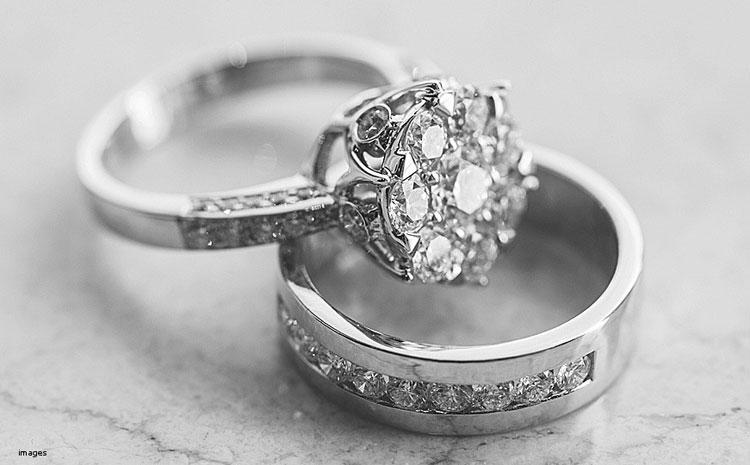
Strength
925 silver is durable and easy to process. Items made from this metal are less scratched. The alloy is practical and less likely to deform.
Castas (seats for the stone) in white alloys are made so that its krapana (legs that hold the stone) do not unbend and the inserts do not fall out, which is a common problem in products made from red and yellow materials.
Brand
The mark is responsible for who made the jewelry and in what year. The manufacturer applies a name at the final stage of production, after which it is handed over to the Assay Office, where the quality of the metal and the content of the required amount of pure silver are checked. If the percentage of content meets the standard, a sample is applied to the jewelry, for example 925.
Application
The strength of the alloy allows it to be used for the manufacture of watch parts and jewelry (bracelets, key rings).
What is 925 Sterling Silver? What are its features?

Photo
Sterling is the name of an alloy of 925 silver. Silver alloys are used to make silverware, jewelry, coinage, and more. Pure silver, 999 standard, is not suitable for these purposes: it is too soft and fragile, quickly oxidizes and loses its appearance.
To give a silver product strength, ductility, noble color and other useful properties, alloys are used - admixtures of other metals. In silver marked 925, there are 7.5% of such impurities.
The following alloying metals can be used: copper, germanium, zinc, platinum, gold and titanium. Silicon and boron are added as auxiliary elements.
The alloy of silver with cadmium is one of the most expensive (much more expensive than gold). It is used in precision instrumentation and science because it has high electrical and thermal conductivity.
Silver alloyed with germanium does not turn black over time. And in combination with aluminum it becomes too porous.
The standard metal used to alloy 925 sterling silver is copper.
Tips for choosing jewelry of this sample
When choosing jewelry, you should pay attention to the presence of markings. All precious goods on store shelves must have manufacturer's tags with contact information and a retail chain price tag.
Expert opinion
Vsevolod Kozlovsky
6 years in jewelry making. Knows everything about samples and can identify a fake in 12 seconds
Please note the absence of piercing elements in the design of the model. The decoration should be comfortable and light. It is advisable that the stone (or path of stones) is not raised too high.
If the product contains diamonds over 4 mm in diameter, see if there is a certificate for the stone.
How to Test a 925 Sterling Silver Item
- Find the rectangle with the hallmark on the product and make sure that the numbers 925 are indicated on it.
- Silver does not have magnetic properties. Test this statement by holding a magnet close to your jewelry.
- Rub the product on a piece of chalk. The crayon has turned black, which means the silver is real.
- Apply a small amount of sulfur ointment to the surface of the product. After a few hours, the fake will change color, and the silver jewelry will only tarnish.
- Determine the authenticity of the item from a jeweler.
Reviews
Victoria, 32 years old: “For me personally, the main difference between silver and white gold is color. The silver is much lighter, the models are ordinary, almost unremarkable. White gold jewelry is dark, bright, and almost always encrusted with diamonds or semi-precious stones.”
Tatyana, 20 years old: “My beloved gave me a ring with a stone, I thought for a long time what kind of metal it was, until I took a magnifying glass and examined “925.” It turned out to be silver..."
Anna, 36 years old: “I don’t understand how to distinguish white gold from silver. As for me, they are exactly the same metals. And is it worth overpaying?
Svetlana, 28 years old: “I adore white gold, but only in its original color without any coatings. A little yellow looks natural and does not require additions. Silver is not for everybody.”
Metric system
At the beginning of the twentieth century, the USSR switched to the metric system, which is more common in the world and easier to understand. Because of the transition, it was ordered that each gold item be graded according to the metric system.
The process of creating a precious alloy itself involves some possible errors regarding the amount of material. To level out these errors, a remedium was installed.
It represents the limit of the maximum deviation from the norm of the quantitative composition of precious metals. For example, in gold-silver, gold-copper and gold-silver-copper alloys the remedium is set to 3 units. That is, if in a gold alloy of 583 purity the gold content should be in the range of 580 - 586 units (58.0% - 58.6%), then the deviation from the norm is 3 percent. Gold alloys containing platinum group metals, namely platinum, nickel, palladium, have a remedium of 5%.
What is silver hallmark?
The quantitative content of silver (or other noble metal) in a master alloy is called fineness. All manufactured jewelry, medals, coins will have a sample of the alloy from which they were made.
The vast majority of countries in the world, including Russia, have a metric system for designating samples. The sample in such a system indicates the number of parts of silver in 1000 parts of the alloy material (by weight). The UK, USA and Switzerland have adopted the carat system. A carat is a measure of thousandth fineness, corresponding to 24 conventional units.
In Tsarist Russia there was a spool system for designating samples. Then the sample denoted the weight amount of noble metal in 96 units of the alloy. There was a coin with the inscription: “990 Proof 1 spool.”
Why is a sample needed?
The sample is guaranteed by the state. It confirms and guarantees that the product has passed the assay control. A mark is placed that is easy to see on each piece of jewelry. But coins, award medals and orders are not subject to branding. This happens because the sample of their alloys is regulated and controlled by the state. Control is carried out by the Assay Supervision Inspectorate. From the mark on a silver item you can get information not only about the composition of the alloy, but also about the country where the item was made.
925 metal, what is it, gold or silver - answers to all questions
Home » Samples of precious metals
When purchasing jewelry, citizens pay attention to the sample, which determines the content of precious metal in the product. A neat tag can be seen on platinum, gold and silver jewelry. At the same time, the question often arises: does 925 standard mean gold or silver products?
The fact is that in appearance they have a pleasant golden hue, but in price they are significantly inferior to other gold bracelets and earrings. In this light, it is necessary to understand this issue in more detail.
Standard samples of silver and gold
Gold and silver in their pure form are not used for making jewelry, since by their nature they are quite soft materials, and it is almost impossible to obtain 100% metal content in the alloy.
In order to determine exactly how much of a particular precious metal is contained in an alloy, samples are used. The higher its value, the purer, and therefore more expensive, the alloy is considered.
Currently, in Russia and the CIS countries the following gold standard system is used:
- 375 is an alloy with a high copper content, therefore it has a reddish tint, which when tarnished can take on a grayish color;
- 585 (or 583) - an alloy based on copper and gold, with a high content of the latter, which has an excellent natural shine, as well as a reddish, pinkish, yellowish tint;
- 750 is a compound of silver, copper and gold, which may have a yellowish or white tint;
- 958 is an alloy of gold and silver of a bright yellow color, which is highly soft.
There is also a conditional highest standard of gold - 1000. It denotes absolutely pure metal. However, it is not possible to achieve it in practice, so it is most often designated by the number 999.
As for the silver standard, this line includes values such as 800, 830, 875, which are cast in the form of an alloy of copper and silver (ligature). The fact is that silver in its pure form is characterized by increased softness, and copper can increase the strength of products.
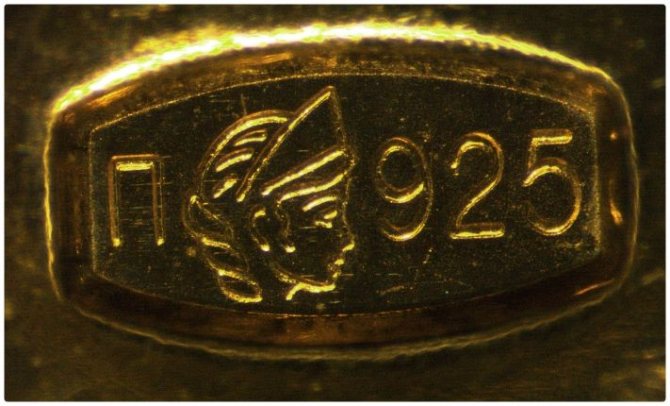
Higher grades - 925, 960 and 999 - are alloys of silver with gold, palladium and pure metal itself.
Hallmark 925 – sterling metal
From the above classification of precious metal samples, it becomes obvious that the 925 value corresponds specifically to silver, not gold. In this alloy, silver is present to a greater extent, which confuses citizens: after all, the jewelry looks like gold, but is inferior in price.

925 silver is sometimes called sterling or sterling (coin) metal. The fact is that in England, back in the Middle Ages, coins were minted from this beautiful and durable alloy. Later it was used to create diamond jewelry as a frame. Nowadays, an alloy that contains 92.5% silver and 7.5% gold and other metals is used for:
- Creation of fine jewelry;
- Production of cutlery;
- Minting of collectible coins.
The base for the 925 alloy is silver, and gilding is applied to its surface, which gives the product a solid look. Since the gold coating is deposited using the galvanic method, it adheres to the jewelry or coin quite firmly.
Thus, the 925 metal is precisely silver, although its yellowish tint may suggest that it is gold. In terms of quality, products made from silver alloy alloyed with gold are distinguished by their solid appearance, high strength and long service life.
Related posts:
958 gold standard - price per gram, alloy composition and features of jewelry
Which gold standard is better - Soviet 583 or 585? Alloys and their features
The highest standard of gold used in jewelry
985 gold standard: price per gram, composition and features of jewelry
What standard does 14 karat gold correspond to – alloy composition and features
333 gold standard - price per gram, composition and features of jewelry of this standard
Rose gold - what is it? Alloy, samples and features of jewelry care
Palladium price per 1 gram today and price dynamics over 10 years
